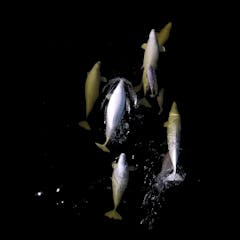
Articles on Whales
Displaying 21 - 40 of 153 articles

Antarctic minke whales are elusive and hard to track – but a new study of their behaviour offers clues to their evolution and the limits of their filter-feeding behaviour.

Drones are a new technology that help researchers observe and record whale behaviours from a distance. But if the drones are flown too low, they change the whales’ behaviour.

The gaping maws and great belch of the Norse ‘hafgufa’ may well have been a humpback whale simply engaging in trap-feeding.

We’ve noticed a clear trend away from singing as a mating tactic among male humpbacks. But it’s probably a pretty good strategy.

Noisy oceans are having a significant impact on marine life.

To fish the oceans sustainably, nations must reduce bycatch, or accidental catches. But fishermen often resist changing gear or techniques that kill nontargeted species.

Swimming and surfing in the ocean is fun and invigorating. But sharing the water with animals comes with risks to us and them.

As the dead whales decompose, an astonishing and rare chain of events is likely to flow through the marine ecosystem – ultimately leading to an explosion of activity and new life.

The declining salmon and whale numbers raise a critical question: Is the southern resident killer whale population solely reliant on the abundance of salmon? And, if so, since when?

The scars many whales bear throughout their lives resulting from shark attacks are more than sufficient evidence sharks will have a go if an opportunity arises.

The Soviet Union was a latecomer to industrial whaling, but it slaughtered whales by the thousands once it started and radically under-reported its take to international monitors.

It’s all based on their diet and how they capture their food. But did you know some whales do have teeth?

I’ve seen whale entanglement in shark nets firsthand, when a humpback whale calf drowned in one a few years back. It was terrible.

We need to advance our understanding of the effects of microplastics on aquatic ecosystems, especially on small animals at the base of food webs that might be ingesting more of these particles.

Migaloo, where are you? How searching for the iconic white humpback whale connects us all with the ocean.

A terrifying sight in ancient waters, the megalodon shark was once the most feared creature in the sea.

Many of Africa’s large aquatic animals, such as dolphins, manatees and turtles, are being killed for meat.

Using our oceans as carbon sinks could help achieve climate goals set in the most recent IPCC report.

Whale species at higher risk of predation from killer whales are more adversely affected by the sound of sonar.

A new report shed light on the migratory routes of 1,000 whales worldwide.
